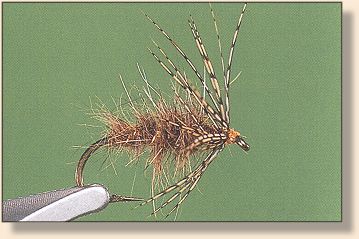March Brown Spider
By Dave Hughes
Soft-hackled wet flies form a lively class of their own, and though they are not
often precisely imitative of mayflies, and therefore not heavily covered in this
book, they do take quite a few trout, often in situations when trout are feeding
on mayflies as well as a minor mix of other insects. At such times the trout
are not selective, and are very susceptible to a fly that swims by with its hackle
opening and closing, looking much like an insect with its legs, antennae, and wings
all kicked about by the currents.
Sylvester Nemes brought these ancient flies to our shores, tracing their origins
to the border region between England the Scotland, with his beautiful little book
The Soft-Hackled Fly (Stackpole, 1975). He lists a small
variety of dressings that work well for him. From his list I've pared out my own,
and would never consider myself very well armed for trout fishing on streams without
the listed March Brown Spider plus his Partridge and Orange, Partridge and Green,
and Partridge and Yellow in sizes 12 to 16.
Each of the dressings consists of a body wound with two layers of the appropriate
color silk thread, a very small hare's mask fur thorax, and one or two turns of gray or
brown partridge hackle. They're simple to tie, and as simple to fish on the swing.
They'll coax a surprising number of trout for you when trout feed on drowned
emergers, duns, and even spinners in the afternath of a mayfly hatch or spinner
fall.
Materials: March Brown Spider
Tying Steps:

1. Fix hook in the vise and start thread behind the eye. The thicker silk will give
an undercolor to the body, the 6/0 will work if you can't find Pearsall's gossamer.
Select a partridge feather with fibers twice as long as the hook gap. Strip the
fuzzy fibers from the base and tie the feather in by the stem so that the fibers
will sweep back when wound.

2. Clip 2-3 inches of oval tinsel and tie it in at the bend of the hook. Wax
the thread with a sticky dubbing wax, and twist hare's mask budding onto it
loosely, so that lots of fibers will work in the current when the fly is fished.

3. Wrap the body forward to the base of the hackle. Wind the rib forward in
three to six evenly-spaced turns. Tie it off and clip the excess. Be sure that the
ribbing does not mat down the loose dubbing. If it does, use your bodkin or a
dentist's root canal tool to rough it up again.

4. Wind one or at most two turns of hackle. If you use two, the second should be
placed tight behind the first. Capture the hackle tip with your thread, then clip or
break off the excess. Work the thread through the hackle to the hook eye.
Form a neat thread head, whip-finish, and clip the thread. If you're using silk,
wax the last inch with beeswax before whip-finishing. ~ Dave Hughes

|





